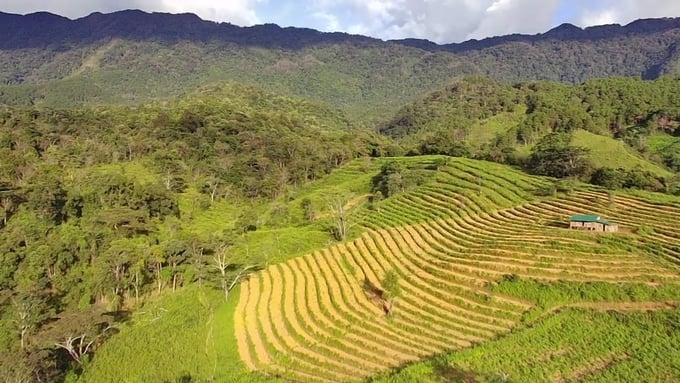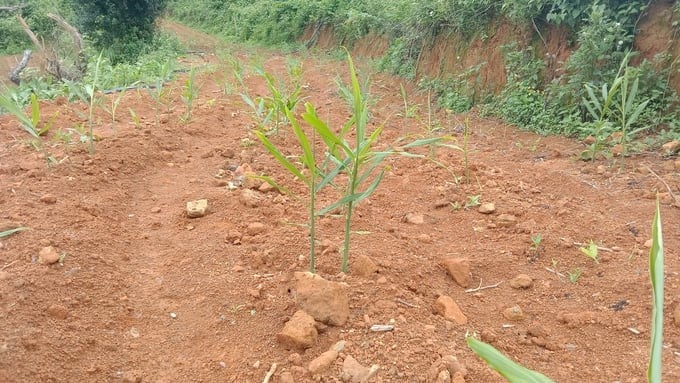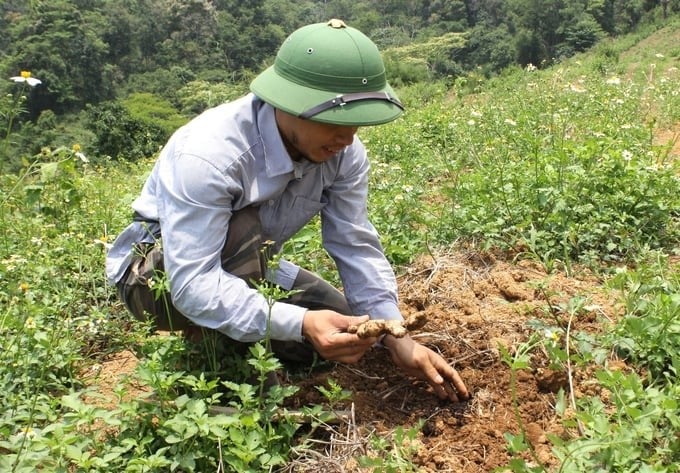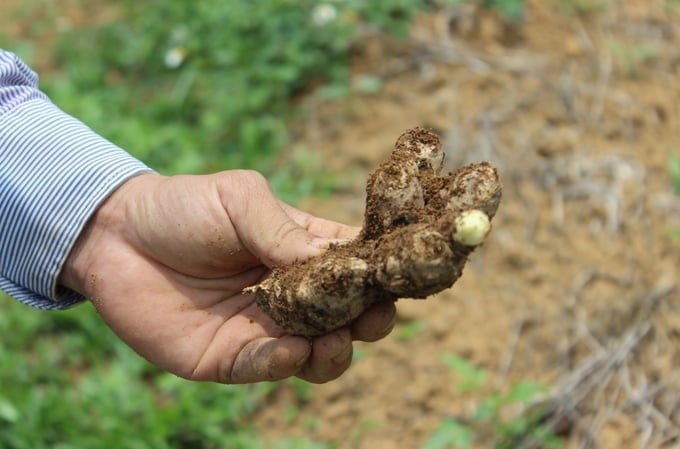November 22, 2025 | 15:28 GMT +7
November 22, 2025 | 15:28 GMT +7
Hotline: 0913.378.918
November 22, 2025 | 15:28 GMT +7
Hotline: 0913.378.918

Xo Dang people grow ginger in the mountain ranges. Photo: Tuan Anh.
The story of linking in growing ginger for export to Europe has become the pride of Xo Dang people in Dak Na commune (Tu Mo Rong district, Kon Tum province).
The raw material area for growing ginger in the mountains and forests of Dak Na is methodically invested. The land is plowed in furrows, lined with a membrane covered by plastic on top. Ginger growing sites are surrounded by a trellis. Many households in Kon Trai village divide weeding, fertilizing, etc.
Linking to grow ginger for export starts in December 2021. At that time, with the desire to develop the ginger raw material area for export, the Tu Mo Rong Agricultural and Medicinal Herb Cooperative was officially established to gather households in Dak Na commune to participate in the linkage chain of growing ginger, turmeric, garlic, etc.

Xo Dang people prepare the soil to grow ginger. Photo: Tuan Anh.
Mr. Ha Van Phuong, Director of Tu Mo Rong Agricultural and Medicinal Herb Cooperative, said that in December 2021, after a survey, Dak Na commune was found to be very suitable for developing into a ginger raw material area for export. Thus, the Cooperative mobilized 15 households to develop a 3-hectare area for growing ginger and turmeric. At that time, the Dak Na Commune People's Committee supported seedlings for people, while the Cooperative supported planting and care techniques and product consumption for people. As of now, the ginger growing linkage chain has grown to more than 16 hectares with 37 participating households.
Due to export purposes, the planting and care processes in the raw material area for ginger production all follow strict, high technical standards and achieve organic certification. Besides, linking with people who are the Xo Dang people in ginger production ensures the criteria for export to Europe.
Particularly, in order for ginger roots to be exported to European countries, the Cooperative also has to carry out many stages, including recording a diary on the app about the growing and care processes so that European customer partners can see the input raw materials of the product while ensuring publicity and transparency.
Mr. A Le (Kon Trai village, Dak Na commune), who is participating in a cooperative group in Kon Trai village and planting about 6 hectares of ginger to serve the export market, said that in the past, his family's economy mainly depended on cassava, and life was very precarious. After that, the family was suggested by the Cooperative to participate in the ginger growing model and was supported with seeds, fertilizers, the care process, and product consumption. Realizing that this was an effective model, his family decided to participate. "Compared to cassava, ginger gives a much higher income; the family is no longer in poverty like before," Mr. A. Le shared.

Ginger trees are increasingly expanding in the area. Photo: Tuan Anh.
Similarly, Mr. A Blinh (Dak Riep 1 village, Dak Na commune), who is also the Cooperative's member participating in linking with 8 households to grow more than 3 hectares of ginger in Dak Riep 1 village, said that "The ginger growing linkage model has brought remarkable economic benefits to people. Here, the Cooperative signed a contract to purchase products for people at a price of VND 7,000–8,000/kg. Not only that, but people are also supported with seeds, fertilizers, and care techniques. Thus, my family seems to only lose money on care. It is obvious that, compared to growing cassava in the past, ginger is becoming the staple crop for my family and many households in the area."
Mr. Ha Van Phuong, Director of Tu Mo Rong Agricultural and Medicinal Herb Cooperative, said that if people plant and take care of it well, on average, 1 hectare of ginger yields about 12–15 tons. At that time, the Cooperative purchases it for people at a price of about VND 7,000–10,000/kg. This price includes support for seeds, fertilizers, and techniques, and people almost just need to put effort into care. Thus, on average, from 1 hectare, people earn a profit of more than VND 100 million. Compared to growing cassava and rice, the ginger growing model brings better economic efficiency to people.
“In the next 3 years, we plan to expand the growing area to about 100 hectares of ginger, turmeric, and garlic. Expanding the growing area aims to create a larger quantity of raw materials for processing and exports to foreign markets," said Mr. Phuong.

Ginger is becoming the staple crop of the Xo Dang people in Dak Na commune. Photo: Tuan Anh.
According to Mr. Nguyen Thanh Thuy, Chairman of the Dak Na Commune People's Committee, as soon as the Cooperative raised the issue of developing a model for growing organic ginger and other products for export to Europe, the local government found it very consistent with reality. In recent times, the policy of Kon Tum province as well as Tu Mo Rong district has been to focus on developing medicinal herb products, including ginger and turmeric, in a sustainable organic direction.
From that policy, the Dak Na Commune People's Committee has created all conditions for organizing village meetings, disseminating and mobilizing people, as well as analyzing the advantages of growing ginger compared to other crops so that people gradually participate in the production linkage chain.

Ginger is very suitable for the land of Dak Na commune. Photo: Tuan Anh.
“Over the past few years of participating in the ginger growing linkage, people's agricultural practices have changed remarkably, introducing mechanization into production step-by-step and installing economical irrigation systems. More importantly, after participating in the ginger growing linkage chain, people's economic lives have improved much compared to before," Mr. Thuy shared.
According to Mr. Thuy, in the coming time, the local government will continue to accompany the Cooperative and people to expand the ginger growing area to create a stable source of income and build raw material areas for export.
Mr. Vo Trung Manh, Chairman of the Tu Mo Rong District People's Committee, said that the ginger growing linkage for export to Europe is a relatively new model for Xo Dang people. Immediately after the business came to survey and establish a cooperative to grow ginger, the District People's Committee accelerated support to get the project into operation soon.
"Compared to other crops, growing ginger does not require high technology and is grown in an organic direction, using little fertilizer, so it is very suitable for people's farming methods. On the other hand, for Xo Dang people who wish to grow trees that quickly yield a harvest, ginger meets the requirement. On the other hand, the selling price of ginger, although not high, is still superior to many other crops in the area," said Mr. Manh.
Translated by Thu Huyen

(VAN) The information was shared at the seminar 'Urban Agriculture - Solutions for Developing Green Spaces,' organized by the Kinh te & Do thi Newspaper and the Biotechnology Center of Ho Chi Minh City.
/2025/11/19/4141-2-132831_216.jpg)
(VAN) One of Japfa's outstanding solutions is implementing digital transformation and artificial intelligence (AI) to optimize operations, enhance productivity, and advance sustainable development.
/2025/11/19/4847-1-093540_448.jpg)
(VAN) The Gia Lai Provincial People’s Committee had a working session with the delegation of the U.S. Department of Agriculture, the State of Idaho, and representatives of the State's leading enterprises.

(VAN) Ca Mau has a sufficient foundation to become a strong regional aquaculture center, where production integrates the economy, the environment, and the lives of the people.

(VAN) SEIKI Group envisions itself as a pioneer in the ‘dual transformation’ of digital technology and green industry, standing alongside the Government and Vietnamese businesses in their pursuit of sustainable development.

(VAN) The VNGEONET network affirms Viet Nam's progress in mastering digital space, providing a precise positioning data platform to serve socioeconomic development.
/2025/11/14/3247-1-184556_35.jpg)
(VAN) Thai Nguyen is methodically implementing digital transformation in the livestock sector, laying the foundation for a modern, transparent, and sustainable agriculture.